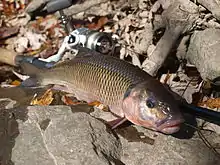Fallfish
The fallfish (Semotilus corporalis) is a North American freshwater fish, a chub in the family Cyprinidae. The fallfish is the largest minnow species native to Eastern North America.
| Fallfish | |
|---|---|
 | |
| Scientific classification | |
| Kingdom: | Animalia |
| Phylum: | Chordata |
| Class: | Actinopterygii |
| Order: | Cypriniformes |
| Family: | Cyprinidae |
| Subfamily: | Leuciscinae |
| Genus: | Semotilus |
| Species: | S. corporalis |
| Binomial name | |
| Semotilus corporalis (Mitchill, 1817) | |
| Synonyms | |
| |
Description
Average specimens generally measure about 5 in (13 cm) in length, but individuals occasionally grow to 15 in (38 cm)[2] with exceptional specimens of more than 19 in (48 cm) having been recorded.[3] Juvenile fallfish have a dark stripe that runs down the center of their body. They are a silvery shade on the top and sides of the body, but have a white shading on the belly. Breeding males develop a pinkish tone on the opercular region, although the species does not develop bright breeding colors. Spawning males build stone nests, known as a redd, which form a prominent part of the bottom on many streams throughout the northeast. Spawning is communal with both males and females joining the nest builder.[4]
Distribution and habitat
They are found in the northeastern United States and eastern Canada, where it inhabits clear streams, lakes, and ponds. They predominately prefer swift currents, however they can also be found in well oxygenated pools. As their name suggests they are often found at the base of waterfalls. Before the introduction of fish such as smallmouth bass, largemouth bass, and brown trout the Fallfish was the apex predator in many streams.[5]
Diet and predation
Juvenile and young fallfish primarily consume chironomids and zooplankton. Once they reach 100mm their diet transitions to small fish (including their own young) and prey of opportunity such as fish eggs and terrestrial insects. There is little overlap between the diets of juvenile and adult Fallfish.[6]
Angling
Fallfish are often encountered when fishing for more desirable species, but their large size, dogged fighting style, powerful runs on light tackle, and willingness to strike make them a worthy quarry in their own right. They will readily take bait, lures, and flies, and have been known to strike lures almost as large as themselves.
The IGFA All Tackle World Record for Fallfish is 3lb 9oz caught by Jonathan McNamara in the Susquehanna River near Owego, New York, USA in April 2009. Previous records come from New Hampshire and Pennsylvania. [7]

_(14752103732).jpg.webp)

References
- NatureServe (2013). "Semotilus corporalis". IUCN Red List of Threatened Species. 2013: e.T202371A18231202. doi:10.2305/IUCN.UK.2013-1.RLTS.T202371A18231202.en.
- "Fallfish, Semotilus corporalis". UNB.CA. University of New Brunswick. Retrieved 20 July 2018.
- "IGFA World Record Fallfish". IGFA World Records Database. International Game Fish Association. Retrieved 20 July 2018.
- "Fallfish". state.nh.us. New Hampshire Fish and Game. Retrieved 26 June 2018.
- Pinder, Mike. "Fallfish: Little Tarpon of the Commonwealth". virginia.gov. Department of Game and Inland Fisheres. Retrieved 14 April 2019.
- James H. Johnson, Christopher C. Nack, and, Marc A. Chalupnicki. "Predation by Fallfish (Semotilus corporalis) on Pacific Salmon Eggs in the Salmon River, New York". bioone.or. Journal of Great Lakes Research. Retrieved 22 April 2019.CS1 maint: multiple names: authors list (link)
- "Fallfish". IGFA.com. International Game Fish Association. Retrieved 26 June 2018.
External links
- Smith, L. C. The Inland Fishes of New York State. New York: The New York State Department of Environmental Conservation. 1985, pp. 155, 156
- Froese, Rainer and Pauly, Daniel, eds. (2007). "Semotilus corporalis" in FishBase. Apr 2007 version.
